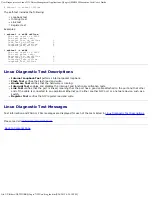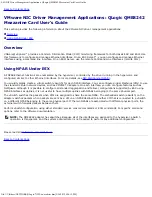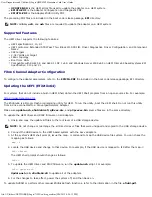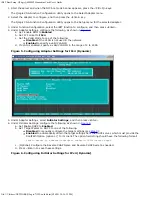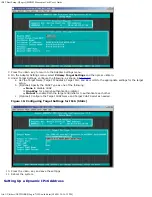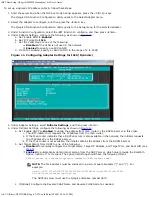
iSCSI Configuration Using Fast!UTIL: QLogic QME8242 Mezzanine Card User’s Guide
file:///T|/htdocs/NETWORK/QLogic/71922/en/fastutil.htm[9/26/2012 4:26:21 PM]
Initiator iSCSI Name
Press <Enter> to configure the iSCSI name of the initiator. Specifying the Initiator iSCSI Name is optional; however, if not
specified, the iSCSI function uses the default iSCSI qualified name (IQN) that is programmed during manufacture. Use this
option to specify an IQN other than the default.
Initiator CHAP Name
Press <Enter> to configure the bidirectional (BIDI) challenge handshake authentication protocol (CHAP) name.
Initiator CHAP Secret
Press <Enter> to configure the BIDI CHAP secret.
Configuring iSCSI Boot Settings
On the
Fast!
UTIL Options menu, select
Configuration Settings
to access the
iSCSI Boot Settings
and specify the drive you
want to boot from. Press the <C> key to clear the boot device information from the primary and alternate boot locations.
NOTE:
For an alternate method of iSCSI boot from SAN, use the fields in the iSCSI Boot Firmware Table (iBFT). For
details, see
iBFT Boot Setup
.
iSCSI boot setup information includes the following:
Boot Device Primary and Alternate
Adapter Boot Mode
Primary and Alternate Boot Device Settings
Configuring the iSCSI Boot Parameters
Configuring the iSCSI Boot Settings
Preparing the Image on the Local Hard Drive
Transferring the OS Image to the iSCSI Target
Booting
Boot Device Primary and Alternate
After configuring a device (through
Primary/Alternate Boot Device Settings
), press <Enter> on these locations to view a
list of available devices. To select an iSCSI boot device, highlight the device, and then press <Enter>.
Adapter Boot Mode
Disable—
Select this option to disable the ROM BIOS on the QME8242 adapter, freeing space in upper memory.
Manual
—Select this option to manually configure the parameters for the iSCSI boot device in the
Primary/Alternate
Boot Device Settings
area. Manual parameters include the following:
Initiator IPv4/IPv6 Address via DHCP
—When set to
Yes
, the QME8242 adapter uses DHCP to obtain its IP
address, subnet mask, and gateway IP address. Press the <Esc> key three times to save the changes. These
values are not populated when you save the settings for the IP address, subnet mask, gateway, IPv6 routable
addresses, and initiator IPv4 or IPv6 address. When DHCP is set to
No
, this field must contain a valid IP
address.
Subnet Mask—
When DHCP is set to
No
, this field must contain a valid subnet mask.
Gateway IP Address—
When DHCP is set to
No
, this field must contain a valid gateway IP address.
Initiator iSCSI Name—
Press <Enter> to configure the iSCSI name of the initiator. By default, the iSCSI name
(containing two parts, the standard product model and serial number) is used. If you change the iSCSI name,
you need to flash the adapter to make the name change permanent.
Initiator CHAP Name
—Press <Enter> to configure the bidirectional CHAP name.
Initiator CHAP Secret
—Press <Enter> to configure bidirectional CHAP secret. You can access the iSCSI Boot
Settings area from the
Configuration Settings
menu. Use these options to specify the drive from which you
want to boot. Press the <C> key to clear the boot device information from the primary and alternate boot
locations.
DHCP
—Select this option to have the initiator acquire its IP address from a DHCP server. The initiator also acquires all
boot parameters for an iSCSI target if the boot parameters are specified on the DHCP server. This setting requires
advanced users to manually input vendor-specific information on the DHCP server and in the
Vendor ID
field of the
DHCP Boot Settings area.
Primary and Alternate Boot Device Settings



